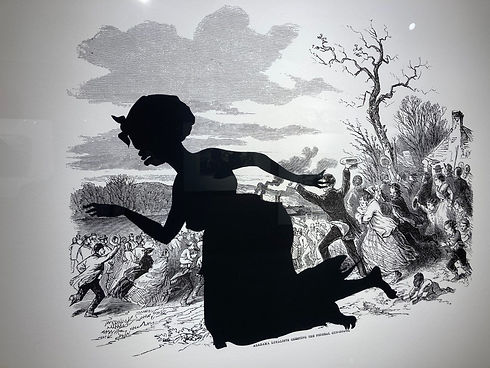

Kara Walker – Figures and Social Commentary
Activator:
Show the video link that displays Kara Walker’s silhouettes. Then introduce the artist and her work in detail through the powerpoint presentation (both included in this lesson plan, see below)
Ask students: "What do you think these figures are trying to say without facial features or expressions?"
Materials:
- Projector
- Whiteboard or projection surface
- Black construction paper
- White background paper
- Pencils, scissors, w-acto knifes, glue sticks
- Images of significant historical or recent scenes of social injustice (printed or digital for projection)
- Optional: Digital devices and software for advanced students
Georgia State Standards:
- VAHSCR.1: Visual Art - Concepts and Critical Thinking
- VAHSAR.1: Visual Art - Artistic Skills and Techniques
- VAHSRE.1: Visual Art - Connections to History and Culture
- VAHSPR.1: Visual Art - Producing Art
- VAHSVA.1: Visual Art - Reflecting on and Evaluating Art
Essential Questions:
- How can silhouettes be used to convey powerful social messages?
- In what ways can art challenge societal norms or historical narratives?
- What makes a visual message impactful?
Lesson Objectives:
- Students will analyze Kara Walker's use of silhouette art to convey complex narratives.
- Students will create a silhouette artwork based on a historical or recent social justice scene.
- Students will present their artwork and discuss its message and visual strategies.
Resource or Artist Reference:
- Kara Walker and her use of the human figure, silhouettes, and historical themes of race, gender, and identity.
- Optional resource: 'Kara Walker: A Subtlety' installation video
Steps and Description:
1. Introduce Kara Walker’s art with visuals and brief background.
2. Discuss the role of silhouettes in storytelling and historical context.
3. Students choose a significant historical or current scene.
4. Project the image onto a whiteboard or wall using a projector.
5. Students trace key figures onto thick black paper or black construction paper.
6. Cut out the silhouettes and glue them onto a white background.
7. Optional: Advanced students can incorporate digital media or create layered scenes.
8. Students write a short reflection explaining their chosen scene and artistic decisions.
9. Present final compositions to the class with reflection.
Closing Activity:
Class gallery walk where students display their silhouette artworks.
Each student writes or shares a reflection using prompts:
- What story are you telling?
- Why did you choose this particular scene?
- How did you decide how to represent the figures visually?
Differentiation:
- Use printed silhouette templates for students needing additional support.
(Click to download a collection of silhouettes)
- Offer simplified tracing options, if projector is not available (see video below)
- Advanced students may use software to build complex scenes with layered symbolism.
Assessment/Rubric:
- Understanding of Kara Walker’s Work (20%)
- Creativity & Concept (25%)
- Technical Skill and Craftsmanship (20%)
- Social Message & Reflection (20%)
- Participation & Effort (15%)
Collaboration:
- Students may collaborate in selecting scenes.
- Peer feedback during gallery walk and class reflection.
Learning Targets
Students will learn to analyze how Kara Walker uses silhouettes to tell complex social stories, and by the end of the lesson will be able to create their own silhouette artwork that communicates a powerful message about a historical or contemporary issue.
Success Criteria:
- I CAN identify and explain themes in Kara Walker’s art.
- I CAN create a silhouette composition that communicates a social message.
- I CAN use traditional art methods to design expressive visual narratives.
- I CAN reflect on and discuss the message and design of my art.
Content Redelivery Methods and other Resources:







